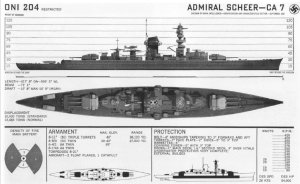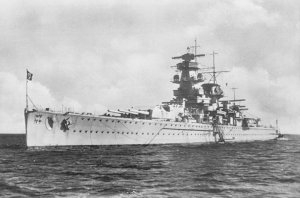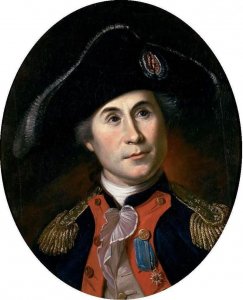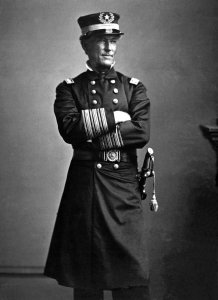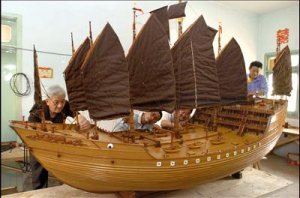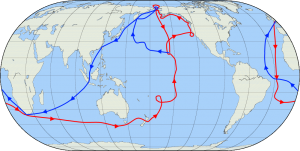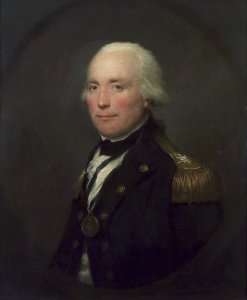Today in Naval History - Naval / Maritime Events in History
28th of June
please use the following link and you will find the details and all events of this day ..... in the following you will find some of the events
1776 - Army Col. William Moultries' troops defend Sullivans Island and Charleston, S.C. from an attack by British Commodore Sir Peter Parker and his fleet during the American Revolution. After a nine-hour battle with casualties mounting, Parker retreats. With Charleston saved, the fort is named in honor of Col. William Moultrie.
The Battle of Sullivan's Island or the Battle of Fort Sullivan was fought on June 28, 1776, during the American Revolutionary War. It took place near Charleston, South Carolina, during the first British attempt to capture the city from American rebels. It is also sometimes referred to as the First Siege of Charleston, owing to a more successful British siege in 1780.
The British organized an expedition in early 1776 for operations in the rebellious southern colonies of North America. Delayed by logistical concerns and bad weather, the expedition reached the coast of North Carolina in May 1776. Finding conditions unsuitable for their operations, General Henry Clinton and Admiral Sir Peter Parker decided instead to act against Charleston. Arriving there in early June, troops were landed on Long Island (now called Isle of Palms), near Sullivan's Island where Colonel William Moultrie commanded a partially constructed fort, in preparation for a naval bombardment and land assault. General Charles Lee, commanding the southern Continental theater of the war, would provide supervision.

1794 - Joshua Humphreys, American shipbuilder and naval architect who designed the U.S. frigate Constitution, familiarly known as “Old Ironsides”, appointed master builder to build Navy ships.

1803 - The Action of 28 June 1803 marked the opening shots of the Blockade of Saint-Domingue after the collapse of the Treaty of Amiens and the outbreak of the War of the Third Coalition in May 1803.
A French heavy frigate and a corvette, both partially armed en flûte and unaware of the recently begun war, met three British 74-gun ships of the line. The corvette was overhauled and captured, but the frigate, sailing close to shore, managed to out-manoeuver her opponent and deliver a devastating raking broadside that put her out of action. The feat of a frigate besting a ship of the line yielded high praise for Willaumez, who had commanded the frigate. A large painting by Louis-Philippe Crépin was commissioned in 1819 to commemorate the event.

Detail from the Fight of the Poursuivante against the British ship Hercules, 28 June 1803: Poursuivantedelivers her decisive raking broadside. Louis-Philippe Crépin, 1819, Musée national de la Marine
1814 - USS Wasp fight HMS Reindeer
The sinking of HMS Reindeer was one of the hardest-fought naval actions in the Anglo-American War of 1812. It took place on 28 June 1814. The ship-rigged sloop of war USS Wasp forced the Cruizer-class brig-sloop HMS Reindeer to surrender after far more than half the brig's crew, including the Captain, were killed or wounded. Reindeer was too badly damaged in the action to be salvaged so the Americans set her on fire.

Action between USS 'Wasp' and HMS 'Reindeer', 28 June 1814 (NMM)

Painting of Marines Aboard USS Wasp Engage HMS Reindeer. June 1814.
1814 - HMS Leopard (50), well known 50-gun Portland-class fourth rate of the Royal Navy, which was onvolved in the so called “Chesapeake – Leopard affair. wrecked near the Island of Anticosti, Gulf of St. Lawrence.
Leopard escorted a convoy from Portsmouth on 6 May 1808.[6] Leopard left the convoy on 28 July at 35°S 7°E. She then was part of the convoy assigned to Josias Rowley in the Mauritius campaign of 1809–11 in the Indian Ocean. In 1812, Leopard had her guns removed and was converted to a troopship. On 28 June 1814 she was en route from Britain to Quebec, carrying a contingent of 475 Royal Scots Guardsmen, when she grounded on Anticosti Island in heavy fog. Leopard was destroyed, but all on board survived.

1904 - Sinking of SS Norge - more than 635 people died
SS Norge [ˈnɔrɡə] was a Danish passenger liner sailing from Copenhagen, Kristiania and Kristiansand to New York, mainly with emigrants, which sank off Rockall in 1904. It was the biggest civilian maritime disaster in the Atlantic Ocean until the sinking of Titanic eight years later, and is still the largest loss of life from a Danish merchant ship.
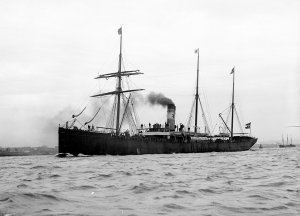
28th of June
please use the following link and you will find the details and all events of this day ..... in the following you will find some of the events
Naval/Maritime History - 27th of August - Today in Naval History - Naval / Maritime Events in History
25 June 1808 HMS Caledonia was a 120-gun first-rate ship of the line (Caledonia-class like HMS Trafalgar) of the Royal Navy, launched on 25 June 1808 at Plymouth. She was Admiral Pellew's flagship in the Mediterranean. H.M.S. Caledonia, 120 guns, lying in Plymouth Sound The Admiralty...
shipsofscale.com
1776 - Army Col. William Moultries' troops defend Sullivans Island and Charleston, S.C. from an attack by British Commodore Sir Peter Parker and his fleet during the American Revolution. After a nine-hour battle with casualties mounting, Parker retreats. With Charleston saved, the fort is named in honor of Col. William Moultrie.
The Battle of Sullivan's Island or the Battle of Fort Sullivan was fought on June 28, 1776, during the American Revolutionary War. It took place near Charleston, South Carolina, during the first British attempt to capture the city from American rebels. It is also sometimes referred to as the First Siege of Charleston, owing to a more successful British siege in 1780.
The British organized an expedition in early 1776 for operations in the rebellious southern colonies of North America. Delayed by logistical concerns and bad weather, the expedition reached the coast of North Carolina in May 1776. Finding conditions unsuitable for their operations, General Henry Clinton and Admiral Sir Peter Parker decided instead to act against Charleston. Arriving there in early June, troops were landed on Long Island (now called Isle of Palms), near Sullivan's Island where Colonel William Moultrie commanded a partially constructed fort, in preparation for a naval bombardment and land assault. General Charles Lee, commanding the southern Continental theater of the war, would provide supervision.
1794 - Joshua Humphreys, American shipbuilder and naval architect who designed the U.S. frigate Constitution, familiarly known as “Old Ironsides”, appointed master builder to build Navy ships.
1803 - The Action of 28 June 1803 marked the opening shots of the Blockade of Saint-Domingue after the collapse of the Treaty of Amiens and the outbreak of the War of the Third Coalition in May 1803.
A French heavy frigate and a corvette, both partially armed en flûte and unaware of the recently begun war, met three British 74-gun ships of the line. The corvette was overhauled and captured, but the frigate, sailing close to shore, managed to out-manoeuver her opponent and deliver a devastating raking broadside that put her out of action. The feat of a frigate besting a ship of the line yielded high praise for Willaumez, who had commanded the frigate. A large painting by Louis-Philippe Crépin was commissioned in 1819 to commemorate the event.
Detail from the Fight of the Poursuivante against the British ship Hercules, 28 June 1803: Poursuivantedelivers her decisive raking broadside. Louis-Philippe Crépin, 1819, Musée national de la Marine
1814 - USS Wasp fight HMS Reindeer
The sinking of HMS Reindeer was one of the hardest-fought naval actions in the Anglo-American War of 1812. It took place on 28 June 1814. The ship-rigged sloop of war USS Wasp forced the Cruizer-class brig-sloop HMS Reindeer to surrender after far more than half the brig's crew, including the Captain, were killed or wounded. Reindeer was too badly damaged in the action to be salvaged so the Americans set her on fire.
Action between USS 'Wasp' and HMS 'Reindeer', 28 June 1814 (NMM)
Painting of Marines Aboard USS Wasp Engage HMS Reindeer. June 1814.
1814 - HMS Leopard (50), well known 50-gun Portland-class fourth rate of the Royal Navy, which was onvolved in the so called “Chesapeake – Leopard affair. wrecked near the Island of Anticosti, Gulf of St. Lawrence.
Leopard escorted a convoy from Portsmouth on 6 May 1808.[6] Leopard left the convoy on 28 July at 35°S 7°E. She then was part of the convoy assigned to Josias Rowley in the Mauritius campaign of 1809–11 in the Indian Ocean. In 1812, Leopard had her guns removed and was converted to a troopship. On 28 June 1814 she was en route from Britain to Quebec, carrying a contingent of 475 Royal Scots Guardsmen, when she grounded on Anticosti Island in heavy fog. Leopard was destroyed, but all on board survived.
1904 - Sinking of SS Norge - more than 635 people died
SS Norge [ˈnɔrɡə] was a Danish passenger liner sailing from Copenhagen, Kristiania and Kristiansand to New York, mainly with emigrants, which sank off Rockall in 1904. It was the biggest civilian maritime disaster in the Atlantic Ocean until the sinking of Titanic eight years later, and is still the largest loss of life from a Danish merchant ship.





